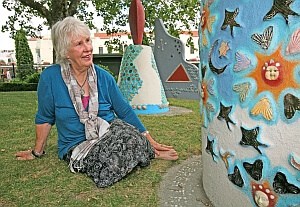You can’t eat it, drink it or play golf with it. Well, my beloved Hastings will never be the city of the Seven Hills or Venice of the South but it has been notable for the creativity of its people.
I think of song writer Canon Wi Huata, singer Philip Rhodes, theatre director Ken Keys, designer David Trubridge, artist Sandy Adsett, writer Barbara Anderson, businessman Sir James Wattie, the extraordinary Live Poets and a wonderful list of wine makers.
When I walk past the vibrant array of artworks in the CBD and in Havelock North I am reminded of this endemic creative spirit.
My greatest buzz of home-town pride came on a visit to Paris in 1999. Suspended high above the Pompidou Centre was a sculpture by Hastings boy Neil Dawson. There, alongside one of the world’s greatest art museums, in full view of thousands of art tourists, it looked just fine.
The importance of how things look goes beyond just having a few sculptures around, though. There is no reason why the functional things in towns, like buildings and utilities, can’t be well designed. I think of a Mãori canoe bailer in the Hawke’s Bay Museum. The simple but loving decoration on it does nothing to make it bail water faster, but it does say something about the sense of community pride and identity felt by the person who made it.
The Hastings District Council is setting a good example with the thoughtful design of projects like the Te Kahika and Karituwhenua stream bridges and the Napier Road Pumping Station. Bouquets should also go to the delightfully painted power box opposite the Opera House and the attractive mural on the old Awatoto Abattoir building (a mural with no garish colours – amazing!).
Not so good, though, are the brutally blank facades of the Queen Street wall of the Farmers and the Tennis & Squash Club building in Whitehead Road. It may not be intentional, but the implied message they give us is that the owners don’t give a toss about the sensibilities of people living nearby or passing by.
Producing art works for public places poses a special set of problems and demands upon the artists and it is interesting talking to local artists about these problems.
William Jamieson (the Clive Gateway sculpture and ‘Resurgence’ on the Karamu Rd – Heretaunga St corner) wonders about how public art should be selected. We agree that it is arrogant to ignore public opinion, but sometimes it takes time for people to tune in to the best work. Jamieson cites the example of Antony Gormley’s ‘Angel of the North’ at Gateshead in England. People hated it when it was first installed in 1998, but it has since become an English icon, attracting many thousands of visitors each year. “I would love to do an ‘Angel of the South’” he adds.
My own personal opinion is that you get the best person you can to do the job and then trust them.
Jamieson is fortunate that his materials of choice, mainly steel, are appropriately robust and he is highly inventive in his exploration of their possibilities. His lattice-work structures echo Mãori taniko and he laments that Jacob Scott’s drinking fountain is the only work in the CBD which really acknowledges the significant Mãori population of Hastings.
After much thinking, the idea for the Clive gateway came to him when driving over the bridge. “I saw the sunlight on the water and it all came to me,” he said. This illustrates an advantage of having good, local people doing these jobs.
Especially valuable, says Jamieson, is the way that local artists have worked in collaboration on projects like the performance stage in Hastings, as well as public commissions outside of Hawke’s Bay.
Liz Earth, whose set of sculptures – ‘Elements’ – stands near the clock tower in the CBD, talks about the creative process. “I like specific projects,” she says, “they focus my thinking.” Even when she is doing something else like gardening, the ideas are still ticking over in the back of her mind as she works things out. As much as any of our artists, Liz Earth’s work tells stories. ‘Elements’ speaks of the earth itself, our relationship with the sun, water (especially our three rivers) as a symbol of emotions, and the understanding of time and space held by the navigators of the Polynesian Triangle. A sculptor by training and then a ceramicist, she acknowledges the need to bring in specialist tradesmen to attend to specific construction requirements.
Not all public art has to be permanent and Liz was part of a sculpture symposium organised by Keith Thorson, using recycled or waste materials such as grape-vine prunings which led to her distinctive series of ‘Nest’ installations.
No local artist surpasses Ricks Terstappen for lateral thinking and improvisation. His materials of choice are often found objects, discards and trade waste which somehow metamorphose into a sort of parallel existence to delight and intrigue us with their improbability.
“Nothing is wasted,” says Ricks. The cut-out pieces of steel from one filigree-like work are welded together in another. “I have always done this,” he says and points to an artwork made from bottle-tops that he did when he was eight years old. The assorted nature of his materials belies the intelligence behind his creations. His family of figures, north of the clock tower in Hastings, are made from the very history of Hastings: old machinery from Watties, springs from railway wagons, power poles etc.
Terstappen has produced an impressive body of works in public both within and outside of Hawke’s Bay, and the profusion of his ideas exemplifies Picasso’s dictum: “I do not search – I find.”
So, who does need public art? Well, I can’t answer that exactly. But when I see a town with good public art I think: this is a town that acknowledges the intelligence and sensibilities of its people and shows belief in its own vitality and identity.



